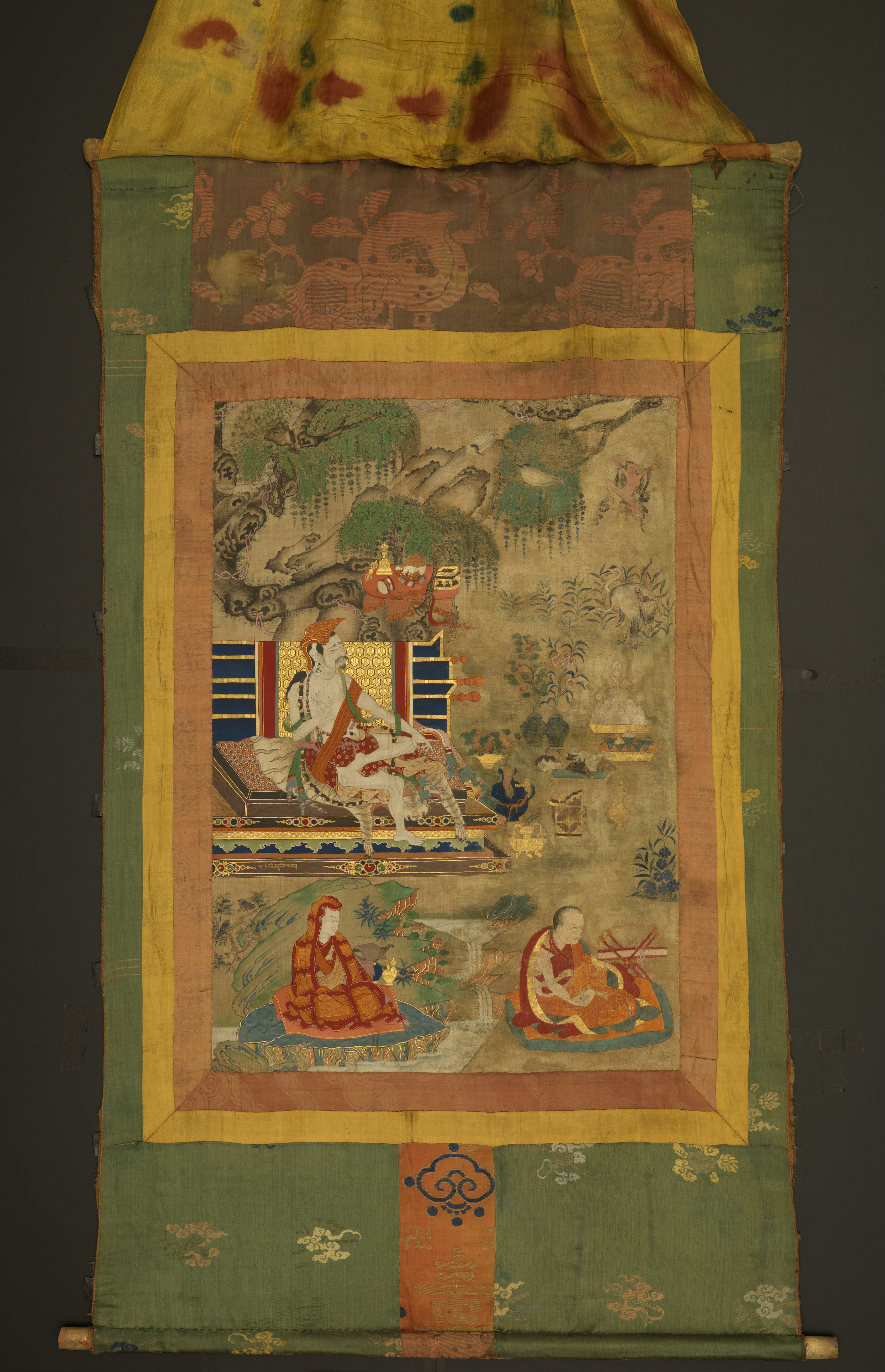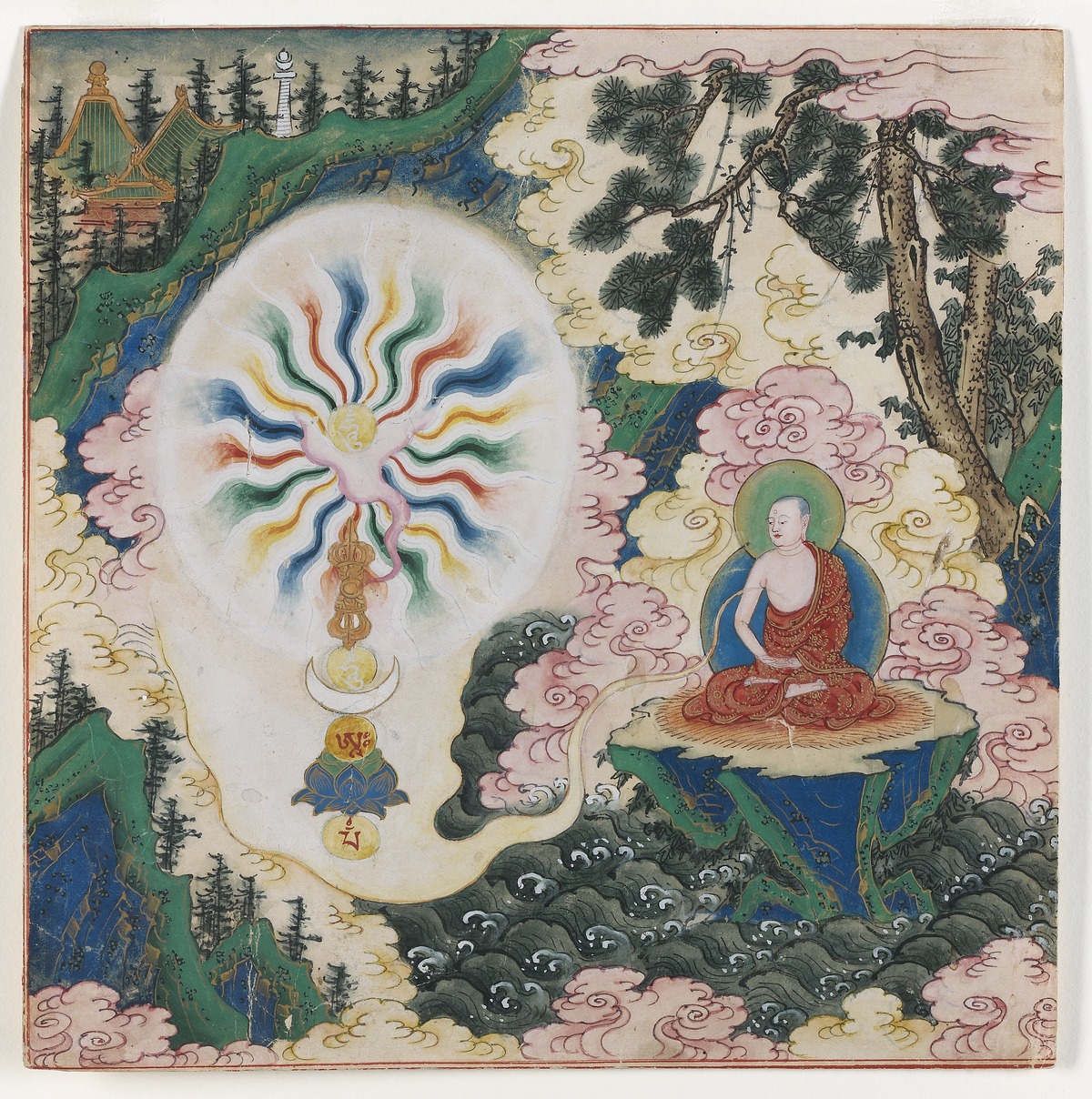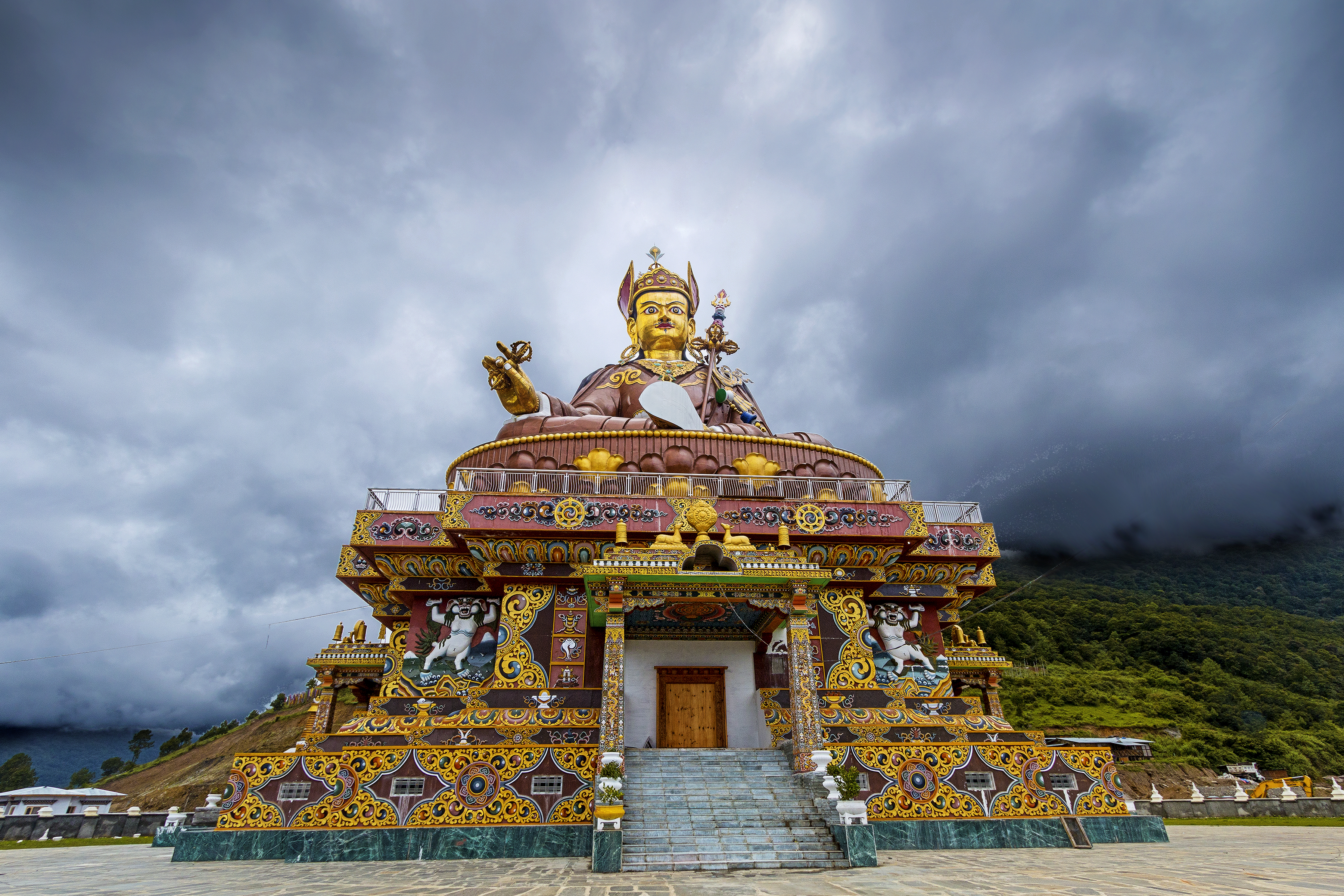|
Karmamudrā
Karmamudrā ( Sanskrit; "action seal," Tibetan: ''las-kyi phyag-rgya''; commonly misspelled as: kāmamudrā or "desire seal") is a Vajrayana Buddhist technique which makes use of sexual union with a physical or visualized consort as well as the practice of inner heat ( tummo) to achieve a non-dual state of bliss and insight into emptiness. In Tibetan Buddhism, proficiency in tummo yoga is generally seen as a prerequisite to the practice of karmamudrā. Karmamudrā also specifically refers to the female yogini who engages in such a practice. When the partner is a visualised one (i.e. imagined by a single yogi in Tibetan tantric practice), it is known as a jñanamudra ("wisdom seal"). Purpose of karmamudra practice Tantra uses skillful means to transform what could tie a practitioner to samsara into a spiritually liberative practice. Judith Simmer-Brown explains how karmamudra can be used to explore the nature of passion: There are traditionally three ways to reali ... [...More Info...] [...Related Items...] OR: [Wikipedia] [Google] [Baidu] |
Six Yogas Of Naropa
The Six Dharmas of Nāropa (, Skt. ''ṣaḍdharma'', "Naro's six doctrines" or "six teachings"), are a set of advanced Tibetan Buddhist tantric practices compiled by the Indian mahasiddhas Tilopa and Nāropa (1016-1100 CE) and passed on to the Tibetan translator-yogi Marpa Lotsawa (c. 1012). Another name for the six Dharmas is "the oral instruction transmission for achieving liberation in the bardo," or "the ''Bardo Trang-dol'' system". Bardo here, refers to the three bardos of waking, sleep and dying. They are also referred to as "the path of means" (''thabs lam'') in Kagyu literature.Kragh (2015), p. 345. They are also sometimes called the ''Six Yogas of Nāropa'' (though not in the traditional literature which never uses the term ''ṣaḍaṅga-yoga'' or ''sbyor-drug''). The six dharmas are a collection of tantric Buddhist completion stage practices drawn from the Buddhist tantras. They are intended to lead to Buddhahood in an accelerated manner. They traditionally ... [...More Info...] [...Related Items...] OR: [Wikipedia] [Google] [Baidu] |
Generation Stage
The fundamental practice of Vajrayana and Tibetan tantra is deity yoga (''devatayoga''), meditation on a chosen deity or "cherished divinity" (Skt. ''Iṣṭa-devatā,'' Tib. ''yidam''), which involves the recitation of mantras, prayers and visualization of the deity, the associated mandala of the deity's Buddha field, along with consorts and attendant Buddhas and bodhisattvas. According to the Tibetan scholar Tsongkhapa, deity yoga is what separates Tantra from Sutra practice. In the Unsurpassed Yoga Tantras, the most widespread tantric form in Indo-Tibetan Buddhism, this method is divided into two stages, the generation stage (''utpatti-krama'') and the completion stage (''nispanna-krama''). In the generation stage, one dissolves one's reality into emptiness and meditates on the deity-mandala, resulting in identification with this divine reality. In the completion stage, the divine image along with the subtle body is applied to the realization of luminous emptiness. The Indi ... [...More Info...] [...Related Items...] OR: [Wikipedia] [Google] [Baidu] |
Sarma (Tibetan Buddhism)
Tibetan Buddhism (also referred to as Indo-Tibetan Buddhism, Lamaism, Lamaistic Buddhism, Himalayan Buddhism, and Northern Buddhism) is the form of Buddhism practiced in Tibet and Bhutan, where it is the dominant religion. It is also in majority regions surrounding the Himalayan areas of India (such as Ladakh, Sikkim, Arunachal Pradesh, and a minority in Himachal Pradesh and Uttarakhand), in much of Central Asia, in the southern Siberian regions such as Tuva, and in Mongolia. Tibetan Buddhism evolved as a form of Mahāyāna Buddhism stemming from the latest stages of Indian Buddhism (which also included many Vajrayāna elements). It thus preserves many Indian Buddhist tantric practices of the post-Gupta early medieval period (500 to 1200 CE), along with numerous native Tibetan developments. In the pre-modern era, Tibetan Buddhism spread outside of Tibet primarily due to the influence of the Mongol Yuan dynasty (1271–1368), founded by Kublai Khan, which had ruled China, M ... [...More Info...] [...Related Items...] OR: [Wikipedia] [Google] [Baidu] |
Samantabhadra 04
Samantabhadra (Lit. "All Good", or "Always Auspicious") may refer to: * Samantabhadra (Bodhisattva), a bodhisattva in Mahayana Buddhism associated with practice and meditation * ''Samantabhadra'' (Tibetan: ''Kuntu Zangpo''), the name of a Buddha, the Adi-Buddha Samantabhadra, in Tibetan Buddhism * Samantabhadra (Jain monk), second-century Digambara head of the monastic order * Samantabhadra (Karmole) Samantabhadra (1891-1988) was a ''Digambara monk Digambara Sādhu (also ''muni'', ''sādhu'') is a Sādhu in the Digambar tradition of Jainism, and as such an occupant of the highest limb of the four-fold '' sangha''. They are also call ... (1891–1988), Digambara monk * Samantabhadra Meditation Sutra, a text teaching meditation and repentance practices {{disambig ... [...More Info...] [...Related Items...] OR: [Wikipedia] [Google] [Baidu] |
Dalai Lama XIV
The 14th Dalai Lama (spiritual name Jetsun Jamphel Ngawang Lobsang Yeshe Tenzin Gyatso, known as Tenzin Gyatso (Tibetan: བསྟན་འཛིན་རྒྱ་མཚོ་, Wylie: ''bsTan-'dzin rgya-mtsho''); né Lhamo Thondup), known as Gyalwa Rinpoche to the Tibetan people, is the current Dalai Lama. He is the highest spiritual leader and former head of the country of Tibet. He was born on 6 July 1935, or in the Tibetan calendar, in the Wood-Pig Year, 5th month, 5th day. He is considered a living Bodhisattva, specifically, an emanation of Avalokiteśvara in Sanskrit and Chenrezig in Tibetan. He is also the leader and a monk of the Gelug school, the newest school of Tibetan Buddhism, formally headed by the Ganden Tripa. The central government of Tibet, the Ganden Phodrang, invested the Dalai Lama with temporal duties until his exile in 1959. The 14th Dalai Lama was born to a farming family in Taktser (Hongya Village), in the traditional Tibetan region of Amdo (administr ... [...More Info...] [...Related Items...] OR: [Wikipedia] [Google] [Baidu] |
Thubten Yeshe
Thubten Yeshe (1935–1984) was a Tibetan lama who, while exiled in Nepal, co-founded Kopan Monastery (1969) and the Foundation for the Preservation of the Mahayana Tradition (1975). He followed the Gelug tradition, and was considered unconventional in his teaching style. Lama Yeshe was born near the Tibetan town of Tolung Dechen, but was sent to Sera Monastery in Lhasa at the age of six. He received full ordination at the age of 28 from Kyabje Ling Rinpoche. Jeffrey Paine reports that Lama Yeshe deliberately refused the geshe degree, despite having studied for it: Sera Monastery did award him an honorary geshe degree in the early 80s. He also used to joke that he was a Tibetan hippie: "I dropped out!" Teaching Western students With the Chinese invasion in 1959 Lama Yeshe made his way to Bhutan and thence to the Tibetan refugee camp at Buxaduar, India. There his teacher Geshe Rabten entrusted to his care a younger monk, Thubten Zopa Rinpoche. The two would work together th ... [...More Info...] [...Related Items...] OR: [Wikipedia] [Google] [Baidu] |
Nyingma
Nyingma (literally 'old school') is the oldest of the four major schools of Tibetan Buddhism. It is also often referred to as ''Ngangyur'' (, ), "order of the ancient translations". The Nyingma school is founded on the first lineages and translations of Buddhist scriptures from Sanskrit into Tibetan in the eighth century, during the reign of King Trisong Detsen (r. 710–755). Nyingma traditional histories consider their teachings to trace back to the first Buddha Samantabhadra (Güntu Sangpo) and Indian mahasiddhas such as Garab Dorjé, Śrī Siṃha and Jñānasūtra. Traditional sources trace the origin of the Nyingma order in Tibet to figures associated with the initial introduction of Buddhism in the 8th century, such as Padmasambhava, Yeshe Tsogyal, Vimalamitra, Vairotsana, Buddhaguhya and Shantaraksita. The Nyingma tradition is also seen having been founded at Samyé, the first monastery in Tibet. Nyingma teachings are also known for having been passed down through ... [...More Info...] [...Related Items...] OR: [Wikipedia] [Google] [Baidu] |
Anuyoga
Anuyoga (Skt. अनुयोग 'further yoga') is the designation of the second of the three Inner Tantras according to the ninefold division of practice used by the Nyingma school of Tibetan Buddhism. As with the other yanas, Anuyoga represents both a scriptural division as well as a specific emphasis of both view and practice. Position in the nine-yana schema Anuyoga is said to emphasise the completion stage of Tantra, where the preceding division, Mahayoga emphasises the generation stage. Dalton (2003: unpaginated) in introducing the literature of the Anuyoga-yana affirms the affiliation of the Anuyoga-yana with the 'completion stage' also known as the 'perfection stage': Modern-day doxographical presentations of the Nyingma school are usually based on the system of the nine vehicles (''theg pa dgu''). Emphasis is placed on the highest three vehicles in this scheme, namely Mahāyoga, Anuyoga, and Atiyoga. Generally speaking, these three “inner” yogas correspond to three s ... [...More Info...] [...Related Items...] OR: [Wikipedia] [Google] [Baidu] |
Gelug
240px, The 14th Dalai Lama (center), the most influential figure of the contemporary Gelug tradition, at the 2003 Bodh_Gaya.html" ;"title="Kalachakra ceremony, Bodh Gaya">Bodhgaya (India). The Gelug (, also Geluk; "virtuous")Kay, David N. (2007). ''Tibetan and Zen Buddhism in Britain: Transplantation, Development and Adaptation,'' p. 39. Routledge. is the newest of the four major schools of Tibetan Buddhism. It was founded by Je Tsongkhapa (1357–1419), a Tibetan people, Tibetan philosopher, Vajrayana, tantric yogi and lama and further expanded and developed by his disciples (such as Khedrup Je, Gyaltsap Je and Gendün Drubpa). The Gelug school is alternatively known as New Kadam (''bKa’-gdams gsar-pa''), since it sees itself as a continuation of the Kadam tradition of Atisha (c. 11th century). Furthermore, it is also called the Ganden school, after the first monastery established by Tsongkhapa. The Ganden Tripa ("Ganden Throne Holder") is the official head of the s ... [...More Info...] [...Related Items...] OR: [Wikipedia] [Google] [Baidu] |
Kalachakra
''Kālacakra'' () is a polysemic term in Vajrayana Buddhism that means " wheel of time" or "time cycles". "''Kālacakra''" is also the name of a series of Buddhist texts and a major practice lineage in Indian Buddhism and Tibetan Buddhism. The tantra is considered to belong to the unexcelled yoga ('' anuttara-yoga'') class. Kālacakra also refers both to a patron tantric deity or yidam in Vajrayana and to the philosophies and yogas of the Kālacakra tradition. The tradition's origins are in India and its most active later history and presence has been in Tibet. The tradition contains teachings on cosmology, theology, philosophy, sociology, soteriology, myth, prophecy, medicine and yoga. It depicts a mythic reality whereby cosmic and socio-historical events correspond to processes in the bodies of individuals. These teachings are meant to lead to a transformation of one's body and mind into perfect Buddhahood through various yogic methods. The Kālacakra tradition is based o ... [...More Info...] [...Related Items...] OR: [Wikipedia] [Google] [Baidu] |
Sakya
The ''Sakya'' (, 'pale earth') school is one of four major schools of Tibetan Buddhism, the others being the Nyingma, Kagyu, and Gelug. It is one of the Red Hat Orders along with the Nyingma and Kagyu. Origins Virūpa, 16th century. It depicts a famous episode in his hagiography when he stopped the sun in the sky. The name ''Sakya'' ("pale earth") derives from the unique grey landscape of the Ponpori Hills in southern Tibet near Shigatse, where Sakya Monastery, the first monastery of this tradition, and the seat of the Sakya School was built by Khon Konchog Gyalpo (1034–1102) in 1073. The Sakya tradition developed during the second period of translation of Buddhist scripture from Sanskrit into Tibetan in the late 11th century. It was founded by Drogmi, a famous scholar and translator who had studied at the Vikramashila directly under Naropa, Ratnākaraśānti, Vagishvakirti and other great panditas from India for twelve years. Khon Konchog Gyalpo became Drogmi's disc ... [...More Info...] [...Related Items...] OR: [Wikipedia] [Google] [Baidu] |



.jpeg/1200px-Tibetan_Buddhism_(214837929).jpeg)




